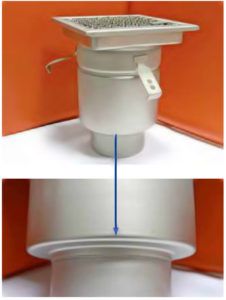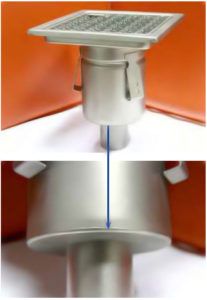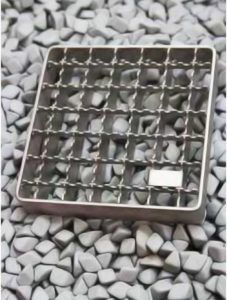
It was only at the turn of the 18th century that serious discussion began on the topic of hygiene and bacteriology. It was in the 19th century that the foundations of our current knowledge on the subject were laid. However, at a time when food was produced locally on small farms and its processing was limited to the seasonal pasteurisation of produce, no one thought of introducing hygienic standards for food production. It was only with the development of industrial food production that the real efforts for safety in food processing began.
Undoubtedly, one material that has aided in this process is stainless steel, and the products made from it are able to meet the highest hygienic standards. It should be remembered, though, that the material itself does not provide an absolute guarantee of hygiene. The growth of microbes and bacteria can take place in any area in which organic residues from the food production process collect.
The use of hygienic materials is only half the battle in assuring food safety on the production line; the other crucial element is the way in which the individual elements are constructed from this material. To achieve a satisfactory product quality that meets the highest hygienic standards, it is essential to implement best practices in hygiene starting as early as the design stage. An awareness of the hygiene requirements of the machinery among the engineering staff permits the elimination of impromptu solutions at the construction stage, which may not meet the hygiene standards that have been set.
Today, as quality and hygiene requirements for food processing plants continue to grow, it is wise for equipment manufacturers to invest in a research and development (R&D) department. The R&D team keeps track of the market existing products and introduces new ones, and supports the work of the sales and design departments. In addition, stainless steel equipment manufacturers can raise the hygienic quality of their components by working closely with food processors to identify troublespots in the production process itself. An analysis of these processes and the creation of production management systems make it possible to create a flexible production process that can be adapted so that the final product meets the highest standards of quality.
By fully engaging the production personnel who have working knowledge of the food product characteristics and process protocols, potential trouble areas can be helps the equipment manufacturer design and engineer components that meet the hygienic needs of the food plant. An asset for manufacturers of stainless steel equipment and components has been the development of laboratory techniques for the study of stainless steel. These studies have resulted in the accumulation of very precise knowledge
about the chemical composition, malleability characteristics and mechanical properties of the material.
This knowledge enables the equipment manufacturer to select the appropriate type of material and machining technology for a given product. The near universal automation of stainless steel machining processes, such as CNC cutting and shaping machinesn and automated welding systems, is another advancement that helps to create smoother and therefore more hygienic surfaces. This combination of detailed knowledge of the material being used, the automation of its production and appropriately selected design technologies means that a final product can be achieved that meets the highest standards of quality and hygiene.
Among relevant examples of technologies that have a positive impact on the manufacturing of stainless steel equipment elements are:
– Pressing elements of the body, trap, and other components means that the number of welded joints can be reduced, thus limiting areas where bacteria can collect. Figure 1 illustrates the smooth surface of a pressed body.

Figure 1. Pressed body. The arrow points to the smooth bottom surface of a pressed drain body, where absence of welds has eliminated a typical hygiene troublespot.

Figure 2. Welded body. The arrow points to the bottom of the drain body, which when produced through automated processes rather than manually, reduces surface irregularities as shown here.
– Eliminating manual welding and replacing it with automated processes reduces irregularities and raises hygiene standards (Figure 2).
– Automation of the pickling and passivation process of stainless steel products is intended to reduce the harmful effects of machining and welding on the passivation layer.
– Abrasive machining of sharp edges eliminates areas where contamination can collect (Figure 3).

Figure 3. A stainless steel mesh grating during the vibro-abrasive process using ceramic mouldings material.
The growth in the number of food processing companies has spurred industry equipment suppliers to consistently raise the quality of the products they sell to guarantee safe and hygienic final food products. One conclusion is clear: It is not the material nor the technology nor good design alone, but rather a combination of the three that results in functional and hygienic equipment. It bears repeating that the technological process consists of many components, all of which need to be continuously developed and monitored, and the combination of all these components results in a product of the highest hygienic standards.
Krzysztof Kaczmarczyk
kaczmarczyk@att.eu
 Następny
Następny
